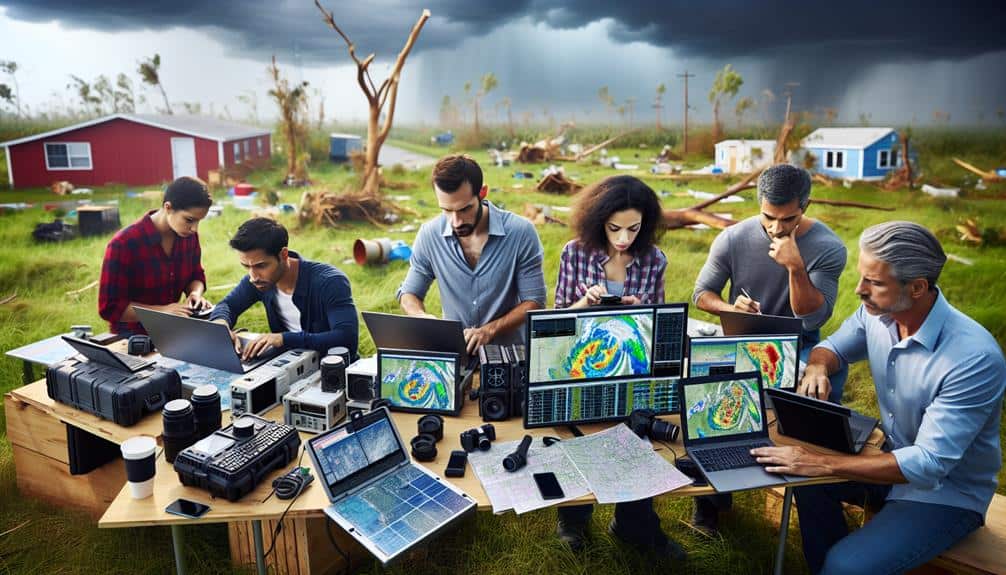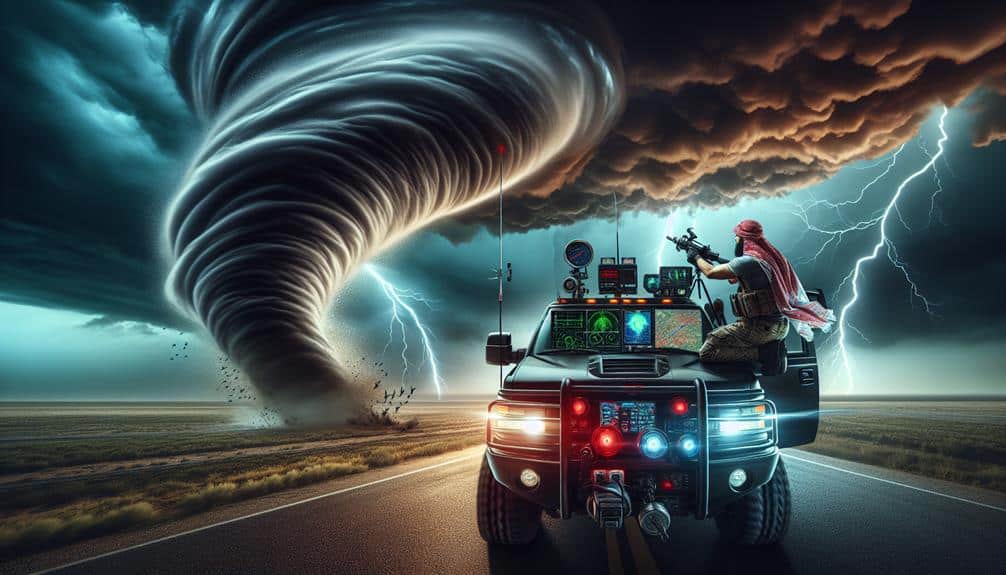We've identified seven vital strategies for effective risk assessment in storm chasing. Analyzing weather patterns helps us predict storm behavior, while advanced technology like Doppler radar and predictive analytics enhances our forecasting accuracy. Solid communication protocols, including encrypted channels and satellite phones, guarantee reliable information flow. Equipping ourselves with safety gear and emergency supplies is essential. Real-time data analysis and team coordination refine our strategies dynamically. Post-storm reviews enhance future risk assessments. By integrating these methods, we greatly enhance our safety and precision in storm chasing activities, crucial components for anyone serious about this work.
Key Points
- Utilize real-time data and predictive analytics to refine storm anticipation and response strategies.
- Employ high-definition satellite imagery and Doppler radar for accurate storm tracking and risk assessment.
- Maintain reliable, independent communication systems with standardized procedures to minimize misunderstandings.
- Equip storm chasers with advanced safety equipment, including weather-resistant clothing and emergency supplies.
Understanding Weather Patterns
Understanding weather patterns is indispensable for storm chasers to accurately predict and assess potential risks. We must analyze atmospheric conditions carefully to enhance our storm prediction capabilities. As climate change continues to influence global weather systems, our forecasting accuracy becomes even more vital.
The evolving nature of weather patterns requires a deep understanding of how these changes impact storm formation and behavior.
We start by examining key atmospheric parameters such as temperature, humidity, wind speed, and pressure gradients. These variables are essential for identifying potential storm development areas.
For instance, sharp temperature differences between air masses can lead to severe weather events. We also have to take into account vertical wind shear, which plays a significant role in the formation of supercell thunderstorms and tornadoes.
With climate change altering traditional weather patterns, our models must adapt to these new variables. Increased sea surface temperatures and shifting jet streams are just a few examples of how climate change affects storm dynamics.
Utilizing Advanced Technology
Leveraging state-of-the-art technology allows us to enhance our storm prediction and risk assessment capabilities significantly. By integrating advanced tech tools, we achieve unprecedented data accuracy and reliability. High-definition satellite imagery and Doppler radar systems are cornerstone technologies that provide real-time data, enabling us to make well-informed decisions swiftly. The integration of these technologies ensures we're not just reactive but proactive in our approach.
Remote monitoring systems play a crucial role in our operations. Utilizing drones equipped with meteorological sensors, we can gather essential data from storm systems without putting ourselves in harm's way. This remote monitoring capability allows us to track storm progression, intensity, and potential impact zones with high precision, offering us the freedom to operate safely and efficiently.
Predictive analytics, powered by artificial intelligence and machine learning, revolutionize our forecasting accuracy. By analyzing vast datasets, these systems can predict storm patterns and potential hazards with exceptional precision. This tech integration not only enhances our data accuracy but also empowers us to deploy resources strategically, thereby minimizing risks and optimizing our response efforts.
In an era where information is power, these technological advancements are essential for modern storm chasers committed to precision and safety.
Communication Protocols
Effective communication methods are vital for coordinating our storm chasing efforts and guaranteeing the safety and efficiency of our operations. By utilizing strong communication strategies, we can streamline our emergency response, minimize risks, and maximize the effectiveness of our data collection.
First, we must establish a reliable primary communication system, typically radio-based, that functions independently of cellular networks, which often falter during severe weather. Using multiple redundant systems, including satellite phones and internet-based communication tools, ensures we maintain contact even in remote areas.
Next, we implement standardized communication procedures. Clear, concise, and standardized language reduces misunderstandings and ensures critical information is accurately transmitted. We use pre-defined codes and signals to convey essential data quickly, such as imminent hazards or changes in storm direction.
Moreover, we designate specific roles within our team to manage communication flow. A central coordinator can prioritize messages and allocate resources effectively. This role is essential during high-stress situations, where rapid decision-making is imperative.
Safety Equipment Essentials
While strong communication protocols are vital for coordination, equipping ourselves with the appropriate safety gear is equally important to reduce the inherent risks of storm chasing. Our safety gear selection must begin with durable, weather-resistant clothing and footwear that can withstand harsh conditions. Helmets and safety goggles are necessary to protect against flying debris.
In addition to personal protective equipment, advanced weather monitoring tools are essential. Portable weather stations, anemometers, and barometers provide real-time data to anticipate storm developments. High-quality communication devices, including satellite phones and two-way radios, are necessary for maintaining contact, especially in areas with poor cellular reception.
Emergency response plans should be enhanced with first aid kits, fire extinguishers, and emergency blankets. GPS devices and paper maps ensure we can navigate even if digital systems fail. It's also wise to have backup power supplies, such as portable chargers and batteries, to keep our equipment operational.
Each piece of gear plays a role in our broader strategy, ensuring we're prepared for any unforeseen circumstances. By focusing on thorough safety gear selection and integrating advanced weather monitoring and communication devices, we can maximize our safety and effectiveness in the field.
Team Coordination

Consistently, successful storm chases hinge on our team's robust coordination and clear communication protocols. We prioritize communication efficiency to guarantee every member is informed about rapidly changing conditions. Using encrypted radio channels and satellite phones, we maintain a seamless flow of information, which is critical for safety coordination. Each team member knows their specific role, whether it's driving, guiding, or monitoring weather updates, making sure we operate as a well-oiled machine.
Resource allocation is another cornerstone of our coordination strategy. We meticulously plan the distribution of equipment, such as GPS devices, first aid kits, and emergency supplies, to optimize our readiness. Assigning these resources to specific team members allows us to respond quickly and effectively to any situation that arises.
In the event of an emergency, our response protocols are designed to be swift and efficient. We've established clear procedures for medical emergencies, vehicle breakdowns, and other unforeseen incidents. Each team member is trained in first aid and emergency response, making certain we're prepared to handle crises without delay.
Real-Time Data Analysis
Leveraging real-time data analysis, we continually refine our strategies by interpreting meteorological data with advanced algorithms and predictive models. This process enables us to anticipate severe weather conditions more accurately and adjust our course in real time.
By integrating dynamic forecasting techniques, we can predict storm trajectories and intensities, which is essential for effective disaster preparedness. Our approach hinges on the seamless integration of diverse data streams—radar, satellite images, ground sensors—into a unified system. This real-time synthesis allows us to generate actionable insights swiftly.
Predictive modeling isn't just about forecasting; it's about refining our emergency response protocols. By anticipating potential hazards, we can coordinate with local authorities to minimize risks and guarantee public safety.
In the field, every second counts. Our ability to process data dynamically means we can respond to evolving situations with agility. It's this precision that empowers us to make informed decisions, enhancing our readiness and resilience.
We're not just chasing storms; we're proactively managing the risks they pose. With real-time data analysis, we transform uncertainty into strategic action, ensuring we're always one step ahead in our pursuit of safety and freedom.
Post-Storm Review

In our post-storm review, we focus on analyzing the data collected to identify improvement areas.
We then update our safety protocols based on these insights.
This systematic approach guarantees we enhance our risk assessment accuracy and operational safety for future storms.
Analyzing Data Collected
We immerse ourselves in the detailed analysis of the data collected during the storm to identify patterns and assess risks. By meticulously examining meteorological readings, radar images, and GPS coordinates, we enhance our data interpretation skills, thereby boosting forecasting accuracy. Each data point serves as an essential piece of the puzzle, revealing the storm's behavior and trajectory.
Risk evaluation becomes the next vital step. We scrutinize the storm's intensity, wind speeds, and precipitation levels to determine the potential hazards. This thorough assessment informs our decision-making strategies, enabling us to prioritize safety while maximizing the effectiveness of our storm chasing missions.
We also consider the human element, reviewing our on-the-ground observations and experiences. This qualitative data complements the quantitative metrics, providing a holistic view of the storm's impact. By integrating these diverse data sources, we refine our risk models and improve our predictive capabilities.
Our analytical approach empowers us to navigate the complexities of storm chasing with greater confidence. We're not just reacting to the storm; we're proactively understanding it. This freedom to anticipate and adapt is essential for both our safety and the success of our future expeditions.
Identifying Improvement Areas
After thoroughly analyzing the data and evaluating the risks, we must now scrutinize our performance to identify improvement areas for future storm chasing missions. This phase, known as post-storm review, is critical for refining our strategies.
We need to focus on quality control to ensure that our data collection and analysis processes are robust. By identifying gaps or inconsistencies, we can implement corrective measures to enhance our overall operational effectiveness.
Continuous monitoring plays a key role in this process. We should review real-time data streams and post-event analyses to pinpoint any deviations from expected outcomes. This helps us understand if our predictive models and risk assessments were accurate or if they need adjustments.
Additionally, we should examine our decision-making processes during the chase. Were there moments where we could have acted more swiftly or decisively? Did our equipment perform to the highest standards?
Updating Safety Protocols
Our post-storm review demands an immediate update of safety protocols to address any identified vulnerabilities and enhance team protection during future chases. We must act swiftly and methodically to refine our emergency response procedures and optimize our risk management strategies. This process involves analyzing data from recent chases, identifying gaps in our current protocols, and implementing improvements to guarantee our safety.
To effectively update our safety protocols, we'll focus on these key areas:
- Communication Systems: Securing real-time updates and reliable communication channels during chases, minimizing the risk of losing contact in critical moments.
- Vehicle Safety: Enhancing vehicle equipment and reinforcing safety measures to withstand severe weather conditions, safeguarding both equipment and personnel.
- Training Programs: Enriching training modules to cover new risks identified during the post-storm review, equipping our team with the latest knowledge and skills.
Frequently Asked Questions
What Are the Legal Implications of Storm Chasing in Different Regions?
Exploring the legal terrain is like chasing the eye of the storm. We must evaluate liability concerns within each jurisdiction, secure appropriate insurance requirements, and obtain necessary permits to guarantee our freedom to storm chase responsibly.
How Do Storm Chasers Secure Funding for Their Expeditions?
We secure funding for our expeditions through diverse funding sources, including grants and crowdfunding. Sponsorship opportunities from weather equipment manufacturers and media outlets also provide essential financial support, allowing us to maintain our independence and pursue our passion.
What Training Is Required to Become a Professional Storm Chaser?
To become professional storm chasers, we've got to undergo extensive training, focusing on weather analysis, equipment essentials, and gaining field experience. This training guarantees we're prepared for the dangers and can operate independently, embracing freedom in our pursuits.
How Do Storm Chasers Manage Mental Health During High-Stress Situations?
Did you know 60% of storm chasers report high stress? We manage mental health using coping techniques like mindfulness and rely on support networks. By staying connected, we maintain focus and resilience in challenging scenarios.
Are There Ethical Guidelines for Interacting With Affected Communities?
We prioritize ethical guidelines by ensuring community engagement and cultural sensitivity. Our interactions with affected communities focus on respecting local customs and providing accurate information, thereby fostering trust and minimizing any potential harm or misunderstanding.


